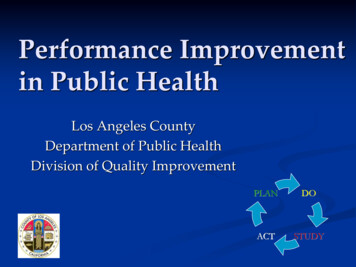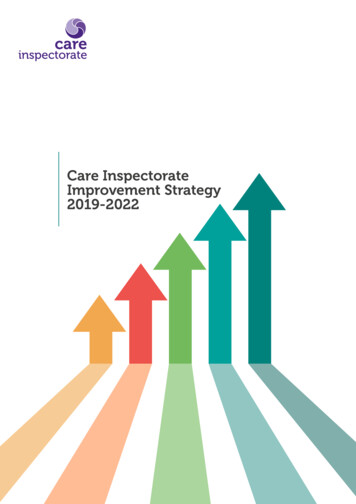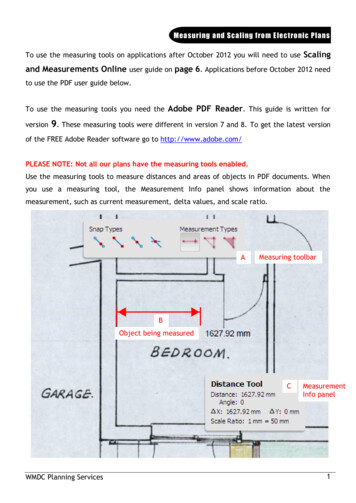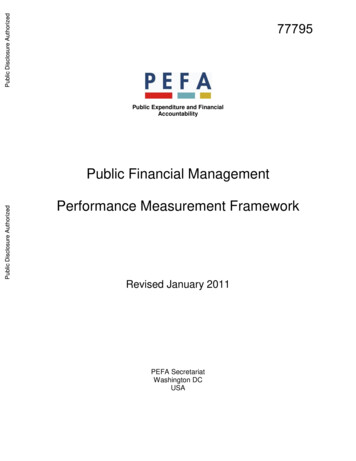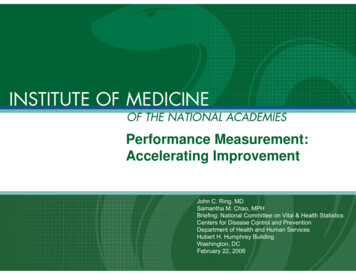
Transcription
Performance Measurement:Accelerating ImprovementJohn C. Ring, MDSamantha M. Chao, MPHBriefing: National Committee on Vital & Health StatisticsCenters for Disease Control and PreventionDepartment of Health and Human ServicesHubert H. Humphrey BuildingWashington, DCFebruary 22, 2006
RATIONALE: MANDATE FOR CHANGE The quality of health care provided in the UnitedStates is suboptimal and uneven. Its cost is considerable. Health care value should be improved.
BACKGROUNDPrevious WorkHealth Care Quality, Cost and ValueINSTITUTE OF MEDICINETo Err is Human: Building A Safer Health System (2000)Crossing the Quality Chasm: A New Health System for the 21st Century (2001)OTHERSBaiker and ChandraFisherHussey et al.Jencks et al.Leatherman and McCarthyMcGlynnReinhardt, et al.(2004)(2003)(2004)(2000)(2002, 2004, 2005)(2003)(2004)
GOALS Enhance the quality of services Reduce waste and inefficiency Promote patient safety Ensure value Foster equity
RESPONSE: CONGRESSMedicare Prescription Drug, Improvement,and Modernization Act of 2003(P.L. 108-173)Section 328 Performance measurement (align payment with performance)Title XVIII—Parts A-C—of the Social Security ActSection 109 Medicare’s Quality Improvement Organization programTitle XI—Part B—of the Social Security Act
RESPONSE: INSTITUTE OF MEDICINECommittee on Redesigning Health Insurance PerformanceMeasures, Payment and Performance Improvement ProgramsThree Reports: The “Pathways to Quality Health Care” Series1. Performance Measurement: Accelerating ImprovementKaren Adams, PhD (December 2005)2. “Quality Improvement Organizations”Dianne M. Wolman, MGA (March 2006)3.“Pay for Performance”Karen Adams, PhD, Rosemary A. Chalk, BA (July 2006)
COMMITTEE MEMBERS Steven A. Schroeder - Chair, University of California, San FranciscoBobbie Berkowitz, University of WashingtonDonald M. Berwick,* Institute for Healthcare ImprovementBruce E. Bradley, General Motors CorporationJanet M. Corrigan, National Committee for Quality Health CareKaren Davis, The Commonwealth FundNancy-Ann Min DeParle, JP Morgan Partners, LLCElliott S. Fisher,* Dartmouth Medical SchoolRichard G. Frank, Harvard Medical SchoolRobert S. Galvin, General Electric CompanyDavid H. Gustafson, University of Wisconsin*Subcommittee on Performance Measures Co-chairs
COMMITTEE MEMBERS Mary Anne Koda-Kimble, University of California, San FranciscoAlan R. Nelson, American College of PhysiciansNorman C. Payson, NCP, Inc.William A. Peck, Washington University School of MedicineNeil R. Powe, Johns Hopkins UniversityChristopher Queram, Wisconsin Collaborative for Healthcare QualityRobert D. Reischauer, The Urban InstituteWilliam C. Richardson, W.K. Kellogg FoundationCheryl M. Scott, Group Health CooperativeStephen M. Shortell, University of California BerkeleySamuel O. Thier, Harvard Medical School and Massachusetts General HospitalGail Wilensky, Project HOPE
SPONSORDepartment of Health and Human Services:Center for Medicare and Medicaid ServicesPROJECT OFFICERS Performance Measurement: Accelerating Improvement– Ms. Lisa Lang “Quality Improvement Organizations” – Ms. Joyce Kelly “Pay for Performance” – Ms. Lisa Lang
THE FOCUS:MEASUREMENT AND PERFORMANCE The current American health care system isperformance impaired. Much needs to be done to realize the bold vision ofquality laid out in the Quality Chasm series of reports. Performance measurement is the key to effectchange. Public reportingClinical quality improvementProvider Accreditation“Pay for Performance”
THE FOCUS:MEASUREMENT AND PERFORMANCEPerformance Measurement: Accelerating ImprovementFrom Report Forward, October 2005:“The only way to know whether the quality of care isimproving is to measure performance.”Harvey V. Fineberg, MD, PhD, MPHPresidentInstitute of MedicineThe National Academies
LIMITATIONS OF THE CURRENT “SYSTEM” Performance evaluation relies on voluntary, consensus-based efforts. Lack statutory authority Lack overarching leadership Critical domains of performance without “owners” will remainunaddressed. Conflicts of interest, both perceived and real, limit engagement andacceptance by stakeholders. Duplication and inconsistency lead to waste. Public confusion Provider burden Knowledge limitation
RATIONALE: KEY RECOMMENDATIONS Our current “non-system” of performanceassessment constitutes an insurmountable barrierto improvement in health care quality, reduction ofcosts and increase in quality. A well-coordinated, national system ofperformance measurement and reporting isessential to achieve these goals.
ALTERNATIVES TO THE CURRENT SYSTEMSupplement and strengthen—not replace—ongoingactivities in the public and private sector Large federal government entity Office within CMS or AHRQ Private stakeholder groups New independent board
PurposeTo continuously reduce the impact and burden of illness, injury, anddisability, and to improve the health and functioning of the people of theUnited StatesAimsEffective, safe, timely, patient-centered, efficient, and equitable careEstablishment of GoalsPromulgation of Standardized MeasuresData Collection and AggregationPublic ReportingAccountability Pay for performance Quality oversight Professional certificationQuality Improvement Health care organizations Patients and cliniciansWere the six aims achieved?Research Agenda Impact AssessmentIntended consequencesUnintended consequencesPopulation Health Access to services Health behaviors Disease surveillance
RECOMMENDATION 1 Congress should establish a National Quality CoordinationBoard (NQCB) with seven key functions:1. Specify the purpose and aims for American health care.2. Establish short and long-term national goals for improvingthe health care system.3. Designate, or if necessary develop, standardizedperformance measures for evaluating the performance ofcurrent providers, and monitor the nation’s progresstoward these goals.(continued)
RECOMMENDATION 1(continued)4. Ensure the creation of data collection, validation, andaggregation processes.5. Establish public reporting methods responsive to the needsof all stakeholders.6. Identify and fund a research agenda for the development ofnew measures to address gaps in performancemeasurement.7. Evaluate the impact of performance measurement on pay forperformance, quality improvement, public reporting, andother policy levers.
RECOMMENDATION 2 The NQCB’s membership and proceduresshould be designed to ensure that the boardhas structural independence, protection fromundue special interests, substantive expertisedrawn from the public and private sectors(including not-for-profit entities), contractauthority, standards-setting authority,financial strength, and external accountability.
RECOMMENDATION 3 Local innovation in pursuit of national goals forimproving health care quality should be encouraged.Performance measurement, improvement, andreporting activities—including those of public andprivate purchasers; accreditation and certificationentities; and federal, state, and local governmentprograms—should be substantially aligned with thenational goals and standardized measures establishedby the NQCB, but local communities should also beencouraged to identify and pursue local priorities, inaddition to helping to achieve national goals.
RECOMMENDATION 4 The NQCB should promulgate measure sets that build on thework of key public- and private-sector organizations.Specifically, the NQCB should: As a starting point, endorse as national standards performancemeasures currently approved through ongoing consensusprocesses led by major stakeholder groups. Ensure that a data repository system1 and public reportingprogram capable of data collection at the individual patient levelare established and open to participation by all payers andproviders. Ensure that technical and financial assistance is available to allproviders who need help in establishing performancemeasurement and improvement capabilities. 1Thedata repository system would collect, validate, and aggregate providerperformance data (see Recommendation 1).
STARTER SETAmbulatory Ambulatory care Quality Alliance (26)CarePrevention measuresa (7), coronary artery diseasea (3), heart failurea(2), diabetes* (6), asthmaa (2), depressiona (2), prenatal carea (2),quality measures addressing overuse or misuse (2)Ambulatory Care SurveyCAHPS Clinician and Group Survey: getting care quickly, gettingneeded care, how well providers communicate, health promotionand education, shared-decision making, knowledge of medicalhistory, how well office staff communicateaThecommittee recommends the aggregation of individual measures to patient-level composites for these areas.
STARTER SETAcute CareaTheHospital Quality Alliance (22)Acute coronary syndromea (7), heart failurea (3), pneumoniaa (6),smoking cessationa (3), surgical infection preventiona (from theSurgical Care Improvement Project) (3)Structural measures (computerized provider order entry,intensive care unit intensivists, evidence-based hospital referrals)Hospital CAHPSPatient communication with physicians, patient communicationwith nurses, responsiveness of hospital staff, cleanliness/noiselevel of physical environment, pain control, communications aboutmedicines, discharge informationcommittee recommends the aggregation of individual measures to patient-level composites for these areas.
STARTER SETHealth PlansandAccountableHealthOrganizationsHealth Plan Employer Data and Information Set (HEDIS)(61)Integrated delivery systems (health maintenanceorganizations): effectiveness (26), access/availability of care(8), satisfaction with the experience of care (4), health planstability (2), use of service (15), cost of care, informed healthcare choices, health plan descriptive information (6)Preferred provider organizations within Medicare Advantage:selected administrative data and hybrid measuresAmbulatory Care SurveyCAHPS Health Plan Survey: getting care quickly, gettingneeded care, how well providers communicate, health planpaperwork, health plan customer service
STARTER SETLong-termCareMinimum Data Set (15)Long-term care (12), short-stay care (3)Outcome and Assessment Information Set (11)Ambulation/locomotion (1), transferring (1), toileting (1), pain(1), bathing (2), management of oral medications (1), acute carehospitalization (1), emergent care (1), confusion (1)End-StageRenalDiseaseNational Healthcare Quality Report (5)Transplant registry and results (2), dialysis effectiveness (2),mortality (1)Longitudinal 1-year mortality, resource use, and functional status (SF-12)measures ofafter acute myocardial infarctionoutcomes andefficiency
RECOMMENDATION 5 The NQCB should formulate and promptly pursue a researchagenda to support the development of a national system forperformance measurement and reporting. The board shoulddevelop this agenda in collaboration with federal agencies andprivate-sector stakeholders. The agenda should address thefollowing: Development, implementation, and evaluation of new measures toaddress current gaps in performance measurement. Applied research focused on underlying methodological issues, suchas risk adjustment, sample size, weighting, and models of sharedaccountability. Design and testing of reporting formats for consumer usability. Evaluation of the performance measurement and reporting system.
RECOMMENDATION 6 Congress should provide the financial resourcesneeded to carry out the research agendadeveloped by the NQCB. The Agency forHealthcare Research and Quality shouldcollaborate with Grantmakers in Health andothers that have ties to local foundations toconvene public- and private-sector stakeholderscurrently investing in various aspects of thisresearch agenda for the purpose of identifyingcomplementary investment strategies.
SUBCOMMITTEE MEMBERS Donald M. Berwick – Co-chair, Institute for HealthcareImprovement Elliott S. Fisher – Co-chair,Patricia Gabow,Lillee Gelinas,Dartmouth Medical SchoolDenver Health and Hospital AuthorityVHA, Inc.Margarita Hurtado,George Isham,American Institutes for ResearchHealthPartners, Inc.Brent James,Intermountain Health CareArthur Levin,Center for Medical Consumers
SUBCOMMITTEE MEMBERS Glen Mays, University of Arkansas for Medical SciencesElizabeth McGlynn, RAND CorporationArnold Milstein, Pacific Business Group on HealthSharon-Lise Normand, Harvard Medical SchoolBarbara Paul, Beverly Enterprises, Inc.Samuel O. Their, Harvard Medical School and MassachusettsGeneral Hospital Paul Wallace, Kaiser Permanente Care Management Institute
QUESTIONS?CONTACT:John C. Ring, M.D.TEL: 202-334-2165E-MAIL: jring@nas.eduBoard on Health Care Services: www.iom.edu/hcsInstitute of Medicine: www.iom.eduNational Academies Press: www.nap.edu
Medicare Prescription Drug, Improvement, and Modernization Act of 2003 (P.L. 108-173) Section 328 Performance measurement (align payment with performance) Title XVIII—Parts A-C—of the Social Security Act Section 109 Medicare's Quality Improvement Organization program Title XI—Part B—of the Social Security Act

